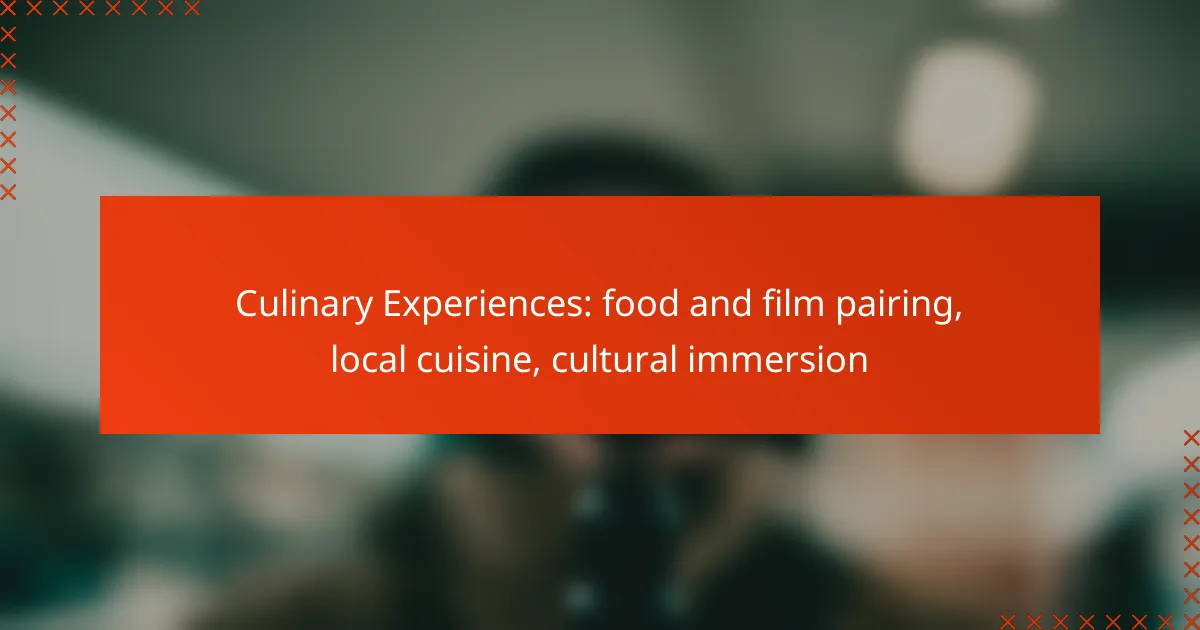Culinary experiences in Australia offer a delightful fusion of food and film, where dishes are thoughtfully paired with movies to enhance the cultural narrative on screen. With a rich tapestry of local cuisine, from bush tucker to coastal seafood, exploring these flavors provides a deeper understanding of Australia’s multicultural heritage. Engaging with local chefs and participating in vibrant food festivals further immerses visitors in the country’s unique culinary traditions.

How to pair food and film in Australia?
Pairing food and film in Australia involves selecting dishes that complement the themes or settings of the movies being screened. This can enhance the viewing experience by immersing audiences in the culture and flavors depicted on screen.
Film festivals featuring culinary themes
Australia hosts several film festivals that spotlight culinary themes, blending cinema with gastronomy. Events like the Melbourne International Film Festival often showcase films centered around food, accompanied by tastings or workshops that allow attendees to experience the cuisine firsthand.
Additionally, festivals such as the Sydney Film Festival may include special screenings paired with local food vendors, creating a unique atmosphere where film lovers can indulge in dishes inspired by the films.
Popular food and film pairing events
Food and film pairing events are increasingly popular in Australia, often held in cinemas or community centers. These events typically feature a curated selection of films alongside meals that reflect the film’s cultural background, enhancing the overall experience.
For example, a screening of an Italian film might be paired with a traditional pasta dish, allowing guests to taste the flavors of the film’s setting. Look for local listings or cinema websites to find upcoming events in your area.
Local restaurants offering film-themed menus
Many Australian restaurants create film-themed menus to coincide with movie releases or festivals. These menus often feature dishes inspired by popular films or directors, providing a fun dining experience for moviegoers.
Restaurants in cities like Sydney and Melbourne frequently update their offerings to align with current films, making it easy to enjoy a meal that complements your cinematic experience. Check restaurant websites or social media for the latest themed offerings and special events.

What are the best local cuisines to explore in Australia?
Australia offers a diverse culinary landscape that reflects its multicultural heritage and regional ingredients. Key local cuisines to explore include bush tucker, seafood from coastal areas, and traditional dishes influenced by Indigenous culture.
Signature dishes from Australian regions
Each Australian region boasts unique signature dishes that highlight local ingredients and traditions. In Queensland, try the Moreton Bay bugs, a type of seafood delicacy, while Tasmania is known for its fresh oysters and artisanal cheeses. The Northern Territory offers bush tucker, which includes native ingredients like kangaroo and wattleseed.
Victoria is famous for its meat pies and the Melbourne-style coffee culture, while Western Australia showcases dishes featuring fresh seafood and native bush foods. Each dish tells a story of the region’s culture and environment.
Top-rated restaurants for local cuisine
For an authentic taste of local cuisine, consider dining at top-rated restaurants such as Attica in Melbourne, known for its innovative use of native ingredients, or Quay in Sydney, which offers stunning views and a modern take on Australian dishes. Other notable mentions include Noma Australia, which features a seasonal menu inspired by local produce.
Reservations are often recommended at these popular spots, especially during peak tourist seasons. Expect to pay around AUD 100-300 per person for a full dining experience, depending on the restaurant and menu selection.
Food markets showcasing local ingredients
Food markets are a great way to experience local ingredients and culinary culture. The Queen Victoria Market in Melbourne is a bustling hub where you can find fresh produce, gourmet foods, and artisanal products. Similarly, the Sydney Fish Market offers a wide variety of seafood directly from the ocean.
Other notable markets include the Fremantle Markets in Western Australia, which feature local crafts and food stalls, and the Adelaide Central Market, known for its diverse range of fresh produce and specialty foods. Visiting these markets can provide a deeper understanding of Australia’s culinary diversity and local flavors.

How to immerse in Australian culinary culture?
To fully immerse in Australian culinary culture, engage with local chefs, explore vibrant food scenes in major cities, and participate in festivals that celebrate the country’s diverse heritage. These experiences provide authentic insights into Australia’s unique flavors and cooking traditions.
Cooking classes with local chefs
Cooking classes with local chefs offer hands-on experiences that teach traditional Australian cooking techniques and recipes. Participants can expect to learn about native ingredients, such as kangaroo, barramundi, and bush tomatoes, while gaining practical skills in a friendly environment.
Look for classes that cater to various skill levels, from beginners to advanced cooks. Many classes are available in cities like Sydney and Melbourne, typically costing between AUD 100 to AUD 250 per person, depending on the duration and complexity of the course.
Culinary tours in major cities
Culinary tours in major Australian cities provide a guided exploration of local food markets, restaurants, and specialty shops. These tours often include tastings of iconic dishes like meat pies, pavlova, and Tim Tams, allowing participants to experience the local palate firsthand.
Consider joining tours that focus on specific themes, such as street food, wine regions, or Indigenous cuisine. Prices vary widely, generally ranging from AUD 80 to AUD 300, depending on the length and inclusions of the tour.
Food festivals celebrating Australian heritage
Food festivals celebrating Australian heritage showcase the country’s culinary diversity and cultural traditions. Events like the Melbourne Food and Wine Festival and the Sydney Royal Easter Show feature local produce, cooking demonstrations, and food competitions, attracting both locals and tourists.
These festivals typically occur annually and provide an excellent opportunity to sample a variety of dishes and beverages. Admission fees can range from free to AUD 50, depending on the festival and specific events within it.

What are the benefits of culinary experiences?
Culinary experiences offer numerous benefits, including enhanced cultural appreciation and opportunities for social connection. Engaging with local cuisine allows individuals to immerse themselves in traditions and flavors, fostering a deeper understanding of diverse cultures.
Enhancing cultural understanding
Culinary experiences serve as a gateway to understanding different cultures. By tasting traditional dishes and learning about their origins, participants gain insights into the history and values of a community. For example, exploring the spices used in Indian cuisine can reveal the region’s agricultural practices and trade history.
Cooking classes or food tours often include storytelling elements that highlight cultural significance. Engaging with local chefs or home cooks can provide personal narratives that enrich the culinary experience, making it more than just a meal but a lesson in heritage.
Building community through food
Food has a unique ability to bring people together, creating bonds over shared meals and experiences. Community events centered around local cuisine, such as food festivals or potlucks, encourage social interaction and collaboration among participants. These gatherings often foster friendships and strengthen community ties.
Additionally, culinary experiences can support local economies by promoting small businesses and local farmers. Choosing to dine at family-owned restaurants or participate in farmers’ markets not only enhances the culinary experience but also contributes to the sustainability of the community.

How to choose the right culinary experience?
Selecting the right culinary experience involves considering your personal tastes, dietary restrictions, and the cultural context of the food and film pairing. Focus on events that resonate with your interests while offering a genuine taste of local cuisine and culture.
Criteria for selecting food and film events
When choosing food and film events, consider the theme and how well it aligns with your preferences. Look for events that feature local ingredients and authentic dishes, as these can enhance the overall experience. Additionally, check the reputation of the event organizers and read reviews from past attendees to gauge quality.
Another important criterion is the setting. A picturesque venue can elevate your enjoyment, whether it’s a cozy restaurant or an outdoor festival. Ensure the atmosphere complements the culinary experience, as ambiance plays a significant role in enjoyment.
Factors influencing local cuisine choices
Local cuisine choices are influenced by cultural traditions, seasonal availability of ingredients, and regional specialties. Understanding these factors can help you appreciate the authenticity of the dishes served. For instance, Mediterranean cuisine often emphasizes fresh vegetables and seafood, while Asian cuisines may highlight rice and spices.
Another factor is dietary restrictions and preferences. Many local cuisines offer vegetarian, vegan, or gluten-free options, but it’s essential to communicate your needs clearly when attending events. This ensures you can fully enjoy the culinary experience without compromising your dietary requirements.

What emerging trends are shaping culinary experiences?
Emerging trends in culinary experiences focus on the intersection of food, culture, and technology. These trends enhance how people engage with local cuisine, often through innovative pairings, immersive dining, and sustainability practices.
Food and Film Pairing
Food and film pairing is gaining popularity as a unique way to enhance the dining experience. This trend involves selecting dishes that complement the themes or settings of a film, creating a multisensory experience for diners. For example, a French film might be paired with classic French dishes, enhancing the overall enjoyment.
To implement food and film pairings, consider hosting themed events where menus are designed around specific films. This can attract cinephiles and food lovers alike, creating a niche market for restaurants. Additionally, offering tasting menus that change with film screenings can keep the experience fresh and engaging.
Local Cuisine
Emphasizing local cuisine is a trend that highlights regional ingredients and traditional cooking methods. This approach not only supports local farmers and producers but also provides diners with authentic culinary experiences. For instance, a restaurant in Italy might focus on seasonal ingredients sourced from nearby farms.
To effectively showcase local cuisine, chefs should develop relationships with local suppliers and incorporate seasonal menus. This not only enhances flavor but also educates diners about the cultural significance of the dishes. Engaging storytelling about the origins of ingredients can further enrich the dining experience.
Cultural Immersion
Cultural immersion in culinary experiences allows diners to engage deeply with the traditions and customs of a cuisine. This trend can include cooking classes, food tours, or interactive dining experiences that educate participants about the cultural context of the food they are enjoying.
For a successful cultural immersion experience, consider offering workshops that teach traditional cooking techniques or hosting events where guests can participate in the preparation of their meals. This hands-on approach fosters a greater appreciation for the cuisine and creates memorable experiences that resonate with diners long after their meal.



